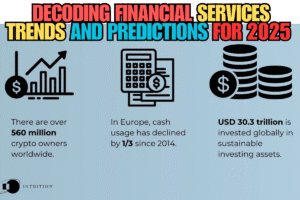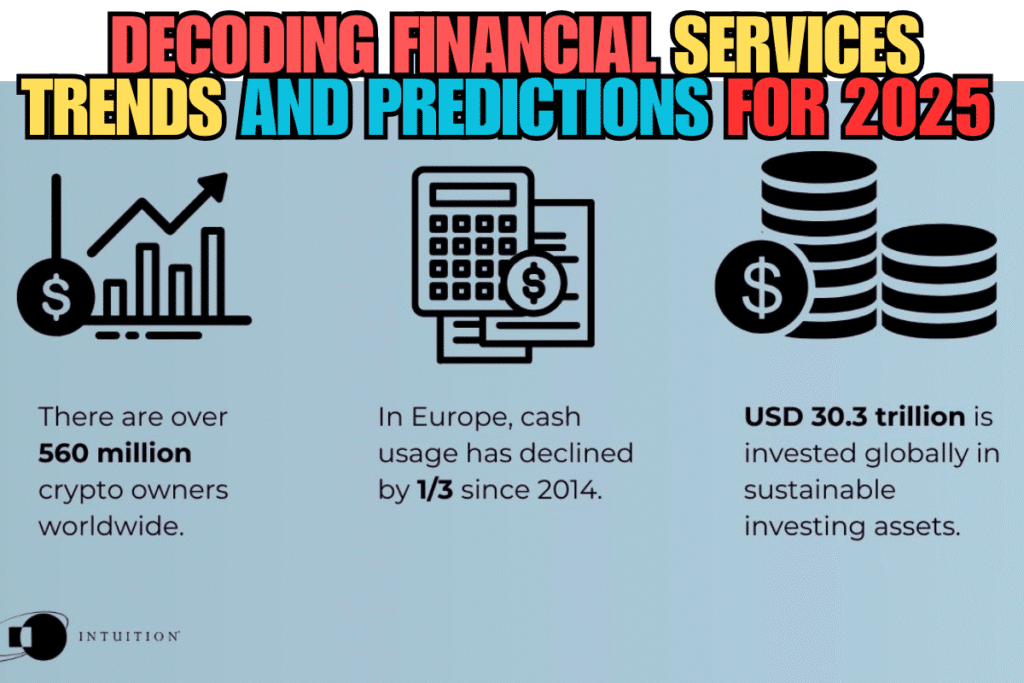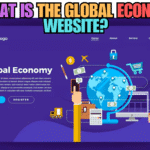The financial services sector, a bedrock of global commerce, is in constant flux. As we navigate the mid-point of the year, the Financial Services Trends and Predictions 2025 are becoming clearer, painting a picture of rapid technological adoption, evolving customer expectations, and a shifting regulatory landscape. This isn’t just about incremental changes; we’re witnessing a fundamental reshaping of how we interact with money, investments, and financial institutions.
Having observed these shifts firsthand, both as a keen analyst and a participant in the evolving digital economy, I can attest that 2025 is poised to be a pivotal year. This isn’t just rehashing industry reports; it’s about synthesizing key trends, adding a layer of practical insight, and exploring the implications for both consumers and the industry itself. Let’s delve into the forces that will define Financial Services Trends and Predictions 2025.
The Reign of AI: From Automation to Autonomous Decision-Making
Artificial intelligence (AI) is no longer a futuristic concept in finance; it’s a pervasive reality, and its influence will only intensify in 2025. We’ve already seen AI powering chatbots and streamlining basic processes, but the next wave involves more sophisticated applications.
- AI-Driven Hyper-Personalization: Expect financial institutions to leverage AI to an even greater extent to understand individual customer needs and proactively offer tailored products and services. This goes beyond simple recommendations, potentially anticipating financial needs before they even arise. Imagine AI analyzing your spending patterns and suggesting optimal savings strategies or flagging potential overspending in real-time (Top 15 FinTech Trends 2025 – Dirox).
- Enhanced Fraud Detection and Prevention: AI’s ability to analyze vast datasets in real-time makes it an invaluable tool in combating increasingly sophisticated financial crime. Expect AI-powered systems to become even more adept at identifying anomalies and predicting fraudulent activities, safeguarding both institutions and consumers (How AI Is Changing Corporate Finance in 2025 – Workday Blog).
- AI in Investment and Wealth Management: Robo-advisors powered by AI are already democratizing wealth management. In 2025, expect these platforms to become even more sophisticated, offering personalized investment strategies and adapting to market fluctuations with greater precision (New fintech innovation in 2025? Speednet’s predictions).
- AI-Augmented Operational Efficiency: Beyond customer-facing applications, AI will continue to streamline internal processes, automate compliance checks, and improve overall operational efficiency within financial institutions (The Future of AI in Financial Services | SS&C Blue Prism).
Personal Insight: I’ve seen firsthand how AI-powered tools can quickly analyze complex financial data, providing insights that would take human analysts significantly longer to uncover. The potential for more accurate risk assessments and personalized financial advice is immense, but it also necessitates careful consideration of ethical implications and data privacy.
The Embedded Finance Revolution: Seamless Integration Everywhere
The trend of embedded finance, where financial services are seamlessly integrated into non-financial platforms, is set to explode in 2025 (Top 15 FinTech Trends 2025 – Dirox). Think of buying a car and securing financing directly through the dealer’s platform, or e-commerce sites offering instant payment options and even micro-loans at the point of sale.
- Frictionless Customer Experiences: Embedded finance eliminates the need to navigate separate financial institutions, creating a more convenient and streamlined customer journey.
- New Revenue Streams: For non-financial businesses, embedding financial services can unlock new revenue opportunities and enhance customer loyalty.
- Increased Accessibility: Embedded finance can reach underserved populations by integrating financial tools into platforms they already use regularly.
Personal Insight: My own online shopping experiences have become increasingly intertwined with embedded finance options. The ease of “buy now, pay later” services or instant financing offers directly within the checkout process is compelling, highlighting the power of this trend in shaping consumer behavior.
The Evolution of Payments: Speed, Security, and New Forms
The way we pay for goods and services continues to evolve rapidly, with several key trends shaping the payments landscape in 2025 (The year ahead in financial services: 10 trends to watch in 2025 | Freshfields).
- Real-Time Payments Become Mainstream: Instant payment systems are gaining traction globally, offering faster and more efficient transactions for both consumers and businesses. Expect wider adoption and new use cases for real-time payments in 2025 (The Future of Finance: 2025 Predictions and Trends – Dwolla).
- Enhanced Security and Biometrics: As digital transactions increase, so does the focus on security. Biometric authentication methods like fingerprint and facial recognition 1 will become even more prevalent in payment apps and platforms (New fintech innovation in 2025? Speednet’s predictions).
- The Rise of Digital Currencies (CBDCs and Stablecoins): While still in their early stages, central bank digital currencies (CBDCs) and stablecoins are gaining momentum. 2025 could see further developments in their pilot programs and regulatory frameworks, potentially reshaping the future of money and cross-border payments (Banking Trends 2025 report: AI, Digital Currencies, Fraud Prevention & More | NTT DATA).
Personal Insight: The convenience of instant payments has already transformed how I handle everyday transactions. The potential for CBDCs to streamline cross-border payments and reduce transaction costs is particularly exciting, though regulatory clarity and security concerns remain crucial.
Open Banking and the Power of Data Sharing
Open banking, which allows secure data sharing between financial institutions and third-party providers, is poised for further expansion in 2025 (The year ahead in financial services: 10 trends to watch in 2025 | Freshfields).
- Personalized Financial Management: Open banking enables the development of innovative apps and services that provide consumers with a holistic view of their finances and personalized insights.
- Enhanced Competition and Innovation: By leveling the playing field, open banking fosters greater competition and encourages the development of new and improved financial products and services.
- Streamlined Processes: Open banking can simplify processes like loan applications and account opening by allowing secure access to relevant financial data.
Personal Insight: I’ve used open banking-enabled budgeting apps that have provided a much clearer picture of my spending habits and helped me identify areas for improvement. The ability to securely connect different financial accounts in one place offers significant convenience and empowers better financial decision-making.
The Regulatory Tightrope: Balancing Innovation and Risk
The rapid pace of innovation in financial services presents a significant challenge for regulators. In 2025, expect an increased focus on establishing frameworks that foster innovation while mitigating risks related to AI, data privacy, and the adoption of new technologies (Financial Services in 2025: Predictions and Emerging Challenges – Aryza).
- AI Governance: Regulators will likely focus on ensuring the ethical and responsible deployment of AI in financial decision-making, addressing issues like bias and transparency (Financial Stability in Focus: Artificial intelligence in the financial system | Bank of England).
- Data Privacy and Cybersecurity: With increasing data sharing and the growing threat of cyberattacks, expect stricter regulations around data privacy and cybersecurity in the financial sector (The year ahead in financial services: 10 trends to watch in 2025 | Freshfields).
- Regulation of Digital Assets: As CBDCs and stablecoins gain traction, expect regulators to develop clearer frameworks for their issuance and use, addressing concerns around consumer protection and financial stability.
Personal Insight: The need for a balanced regulatory approach is clear. Overly restrictive regulations can stifle innovation, while insufficient oversight can create systemic risks. Finding the right equilibrium will be crucial for the sustainable growth of the financial services sector.
Navigating a Transformative Landscape
The Financial Services Trends and Predictions 2025 point towards a year of significant transformation, driven by the accelerating adoption of AI, the rise of embedded finance, the evolution of payments, the expansion of open banking, and a dynamic regulatory environment. For financial institutions, agility and a willingness to embrace these changes will be crucial for staying competitive. For consumers, these trends promise more personalized, convenient, and potentially more efficient financial experiences, but also necessitate greater awareness of data privacy and security.
The financial services landscape of 2025 will be defined by innovation and adaptation. Those who can navigate this evolving terrain effectively will be best positioned to thrive in the years to come.
What are your thoughts on these Financial Services Trends and Predictions 2025? Which trend do you believe will have the biggest impact? Share your insights and predictions in the comments below!



